PRACTICE EFFICIENCY
HOW TO GET GREAT RESULTS FROM YOUR GUITAR PRACTICE
If you want to get more results from your guitar practice then one of the best places to start is to think about how to improve your Practice Efficiency.
Practice Efficiency is a question of how to practice the guitar in the best ways to make the fastest improvements, rather than what to practice.
What to practice is a different question, but the principles of practicing efficiently — no matter what you are practicing — are easy to understand and are applicable to every student.
"TALENTED" - OR JUST REALLY GOOD AT PRACTICING?
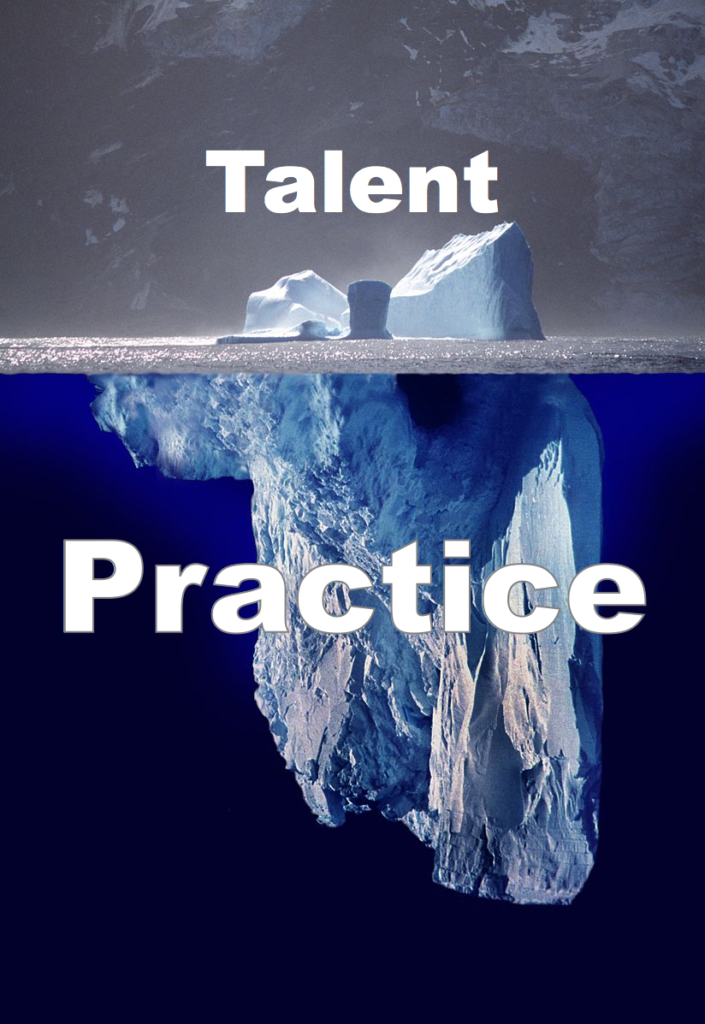
A consistent trait of guitarists who advance quickly and appear to be ‘talented’ is that they are naturally very efficient practisers. Put simply, they get far more out of their practice than other people.
This creates a positive cycle in which they want to practice more, to get more results. Repeated over time, this process is what makes someone a very good guitar player.
However, with inefficient practice habits, the precise opposite happens: guitar practice results in little to no progress, and practice quickly becomes uninspiring or a chore to be avoided.
This is the ‘vicious circle’ many players become caught in and don’t now how to fix.
Fortunately, it’s easy to start turning this around.
You can learn the habits of efficient guitar practice, and by doing so you’ll enjoy far better results in your playing and more motivating practice sessions.
WHAT DOES PRACTICE EFFICIENCY LOOK LIKE?

To demonstrate the power of efficient guitar practice we’ll use the example of two different students in a situation every guitarist has found themselves in countless times – learning a song, and coming up against a tricky bit within the song that you can’t play.
“I just can’t get this bit right!”
Let’s imagine we’re dealing with a tricky bit that happens in a particular section of a song, and let’s say the tricky bit comes up at the end of the section. This would be a very common scenario.
What we have is a section of music with a tricky bit within it.
Let’s imagine the whole section is twenty seconds long, and takes twenty seconds to play back in full. However, the tricky bit itself is only about two seconds long at the end of the section.
A TALE OF TWO STUDENTS

Let’s see how two different guitar students would approach this problem.
Our first student, Student A, is a pretty typical guitar student. Whenever he makes a mistake in his practice, or reaches a part he consistently can’t play, he returns to the beginning of the section every time and repeats everything leading up to the problem.
If he sits down to practice guitar for one minute, Student A practices the part he actually needs to work on 3 times (60 seconds, divided by the 20 seconds it took to replay the whole section). If he spends 10 minutes practice time doing this, he will practice the part he needs to work on 30 times.
Repeating something 30 times might sound like quite a lot? Not a bad use of 10 minutes practice, you might think.
30 TIMES IN 10 MINUTES! - THAT'S A LOT... RIGHT?
It really isn’t. To see why, let’s look at our second guitar student – Student B – who does things differently.
Student B separates the difficult part from the section, and spends his practice time focusing just on that. (Remember, the section was 20 seconds long, but the tricky part at the end was barely 2 seconds).
By approaching the problem efficiently, Student B has already practiced the tricky part 30 times in the space of just one minute. (60 seconds, divided by the 2 seconds it takes to practice the actual tricky bit). That’s the same amount of actual practice as Student A did in 10 minutes.
But let’s say Student B keeps this up for 10 minutes too, so for the same amount of time as Student A. In 10 minutes, he will have practiced the tricky part 300 times! (10 x the 30 repeats he can make in one minute).
After a single ten minute practice session in one day, here’s where our two different students stand:
Student A has practiced the tricky bit 30 times
Student B has practiced the tricky bit 300 times!
As you can see, it’s a tenfold difference. That’s gigantic.
Or is it?
THE REAL RESULTS OF PRACTICE EFFICIENCY OVER TIME
The important point here is that we were only talking about one day in the example above — one ten minute practice session on one day. Real guitar practice is cumulative, so to get a true picture of their results we really need to look at how this situation develops as our two students practice over the next few weeks and months.
Let’s keep the practice to ten minutes a day for simplicity, and let’s see what happens to their numbers above after one week.
Remember, in the space of the ten minutes Student A repeats the tricky bit 30 times. In the same time period, Student B repeats it 300 times.
RESULTS AFTER ONE WEEK
Student A – 210 times (7 days x 30 repeats in one session)
Student B – 2100 times (7 days x 300 repeats in one session)
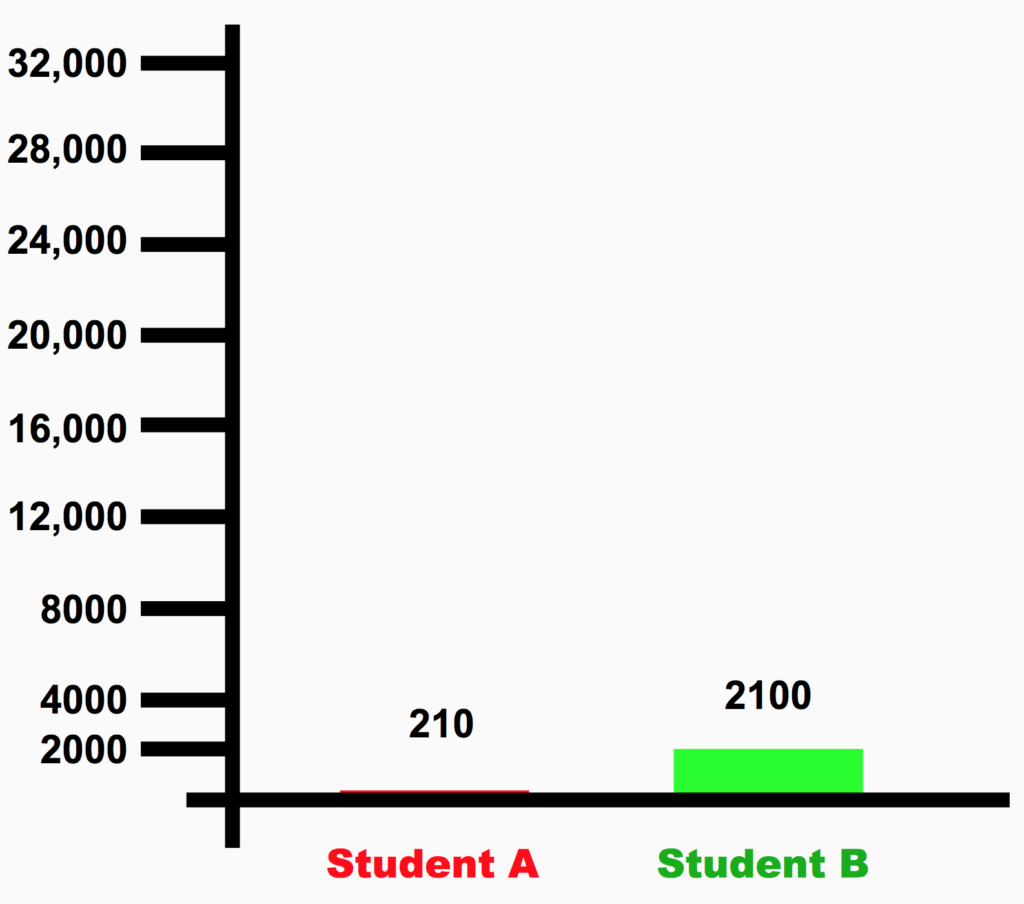
RESULTS AFTER ONE MONTH
Student A – 210 times (7 days x 30 repeats in one session)
Student B – 2100 times (7 days x 300 repeats in one session)

And after a longer time, say 3 months, here is what happens:
RESULTS AFTER THREE MONTHS
Student A – 2700 times (90 days x 30 repeats in one session)
Student B – 27,000 times (90 days x 300 repeats in one session)
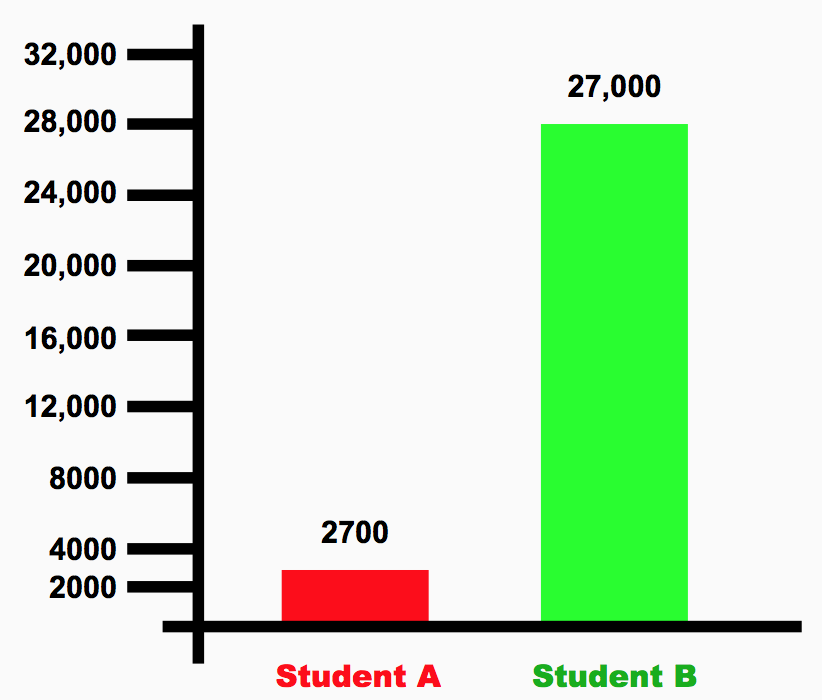
The really interesting thing is that both of our students are putting in the same effort, and both are ‘practicing for the same amount of time’. More accurately, they both ‘feel like’ they are doing the same amount of practice. In reality, they are not.
What makes the difference is their practice efficiency, in this case coming from a simple habit — one student zeroes in on the difficulty, while one repeats the entire section containing the mistake. This completely changes their results.

If we look at the numbers above it appears that the difference between the two students is always just ten times the amount of practice (‘just ten times’ – hah!). But it’s not.
We don’t just need to think about the proportional difference (which is constant), we also need to think about the overall difference. The overall difference is the real difference between their total amounts of practice. Here are the differences in the number of times each student practices the tricky bit:
After a single practice session, the difference is 270 (30 vs 300 repeats)
After one week of practice, the difference is 1890 (210 vs 2100 repeats)
After one month of practice, the difference is 8100 (900 vs 9000 repeats)
After three months of practice, the difference is 24,300 (2700 vs 27,000 repeats)
If we continued like this over some more time, the differences become even larger.
In fact, the difference is becoming so huge and Student B is now so far ahead of Student A, that we need to completely change the scale of the graph:
RESULTS AFTER SIX MONTHS
Student A – 5400 (180 days x 30 repeats in one session)
Student B – 54000 (180 days x 300 repeats in one session)
Difference of 48,600
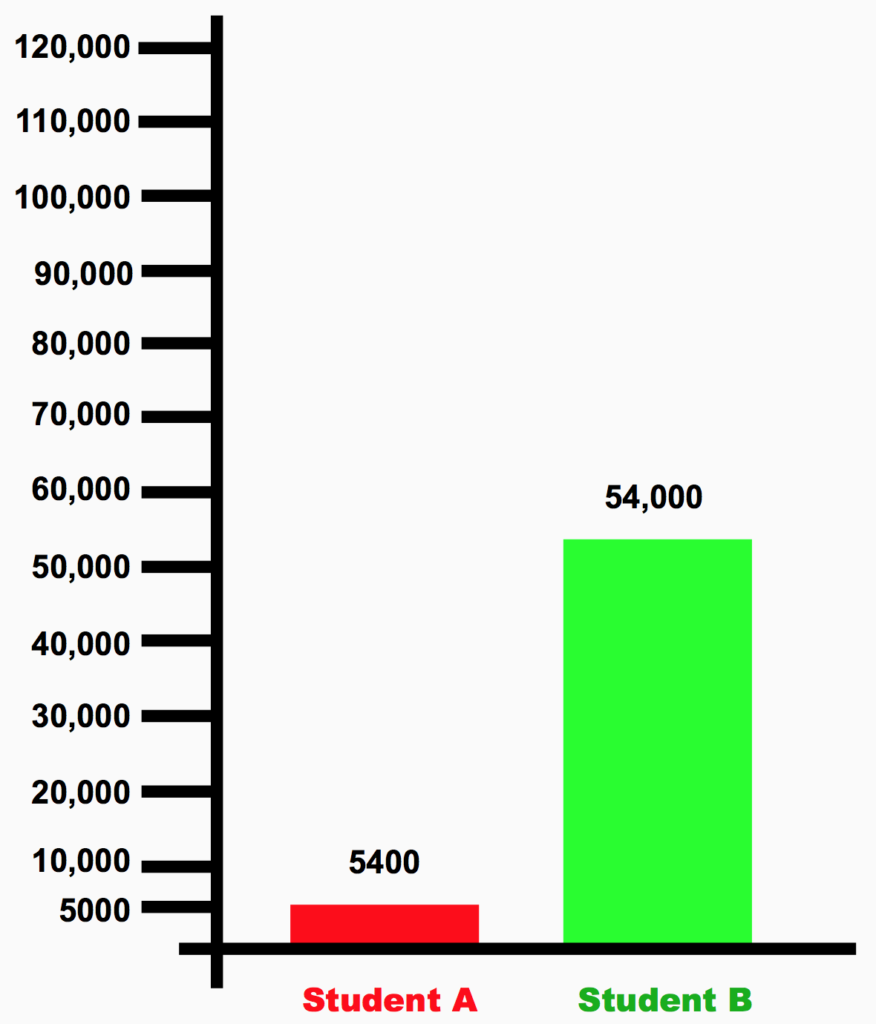
RESULTS AFTER ONE YEAR
Student A – 10,950 (365 days x 30 repeats in one session)
Student B – 109,500 (365 days x 30 repeats in one session)
Difference of 98,550

And there you have it. A tenfold difference in practice efficiency — which is easy to achieve — means the tricky part has been practiced almost a hundred thousand more times by the end of a year.
10x GREATER EFFICIENCY = 100,000 MORE TIMES PRACTICING THE PART…
....in exactly the same amount of time!
What we’re looking at here is more like an exponential difference. The two students start off at the same stage, but the absolute difference between the amount of real practice each has done becomes larger and larger very rapidly as some time passes.
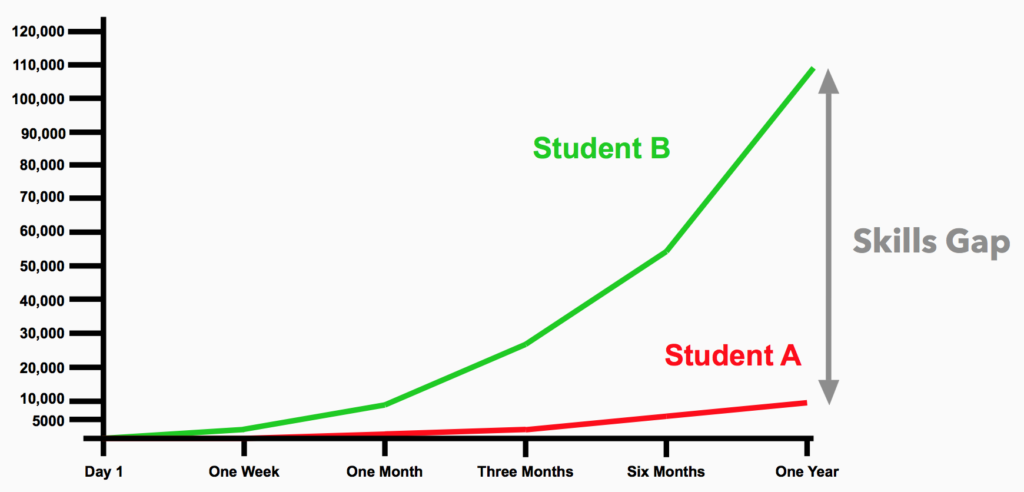
As you can see on the graph, Student A is barely registering after a year of practice, while Student B approaches a hundred thousand repeats. If this were to continue for just a couple of years, Student A would need to practice for more than 20 years at his current rate to catch up with Student B!
This is a perfect example of one of the differences between people who progress quickly, and people who go round in circles making little progress and taking a very long time even to master basic things.
Many times, people wrongly assume that if they are not progressing quickly (or as quickly as other people they know) then there is something wrong with them and they don’t have talent. But as you can see from this example, small differences in practice habits produce huge differences in results.
PRACTICE IS WHAT PRODUCES TALENT
Let’s think about it:
IF YOU PRACTICE SOMETHING A HUNDRED THOUSAND TIMES MORE THAN SOMEONE ELSE
WHO DO YOU THINK IS GOING TO SOUND BETTER?
When two people’s overall practice time is the same or similar, yet one gets amazing results while the other doesn’t, you can see why some people believe the answer is something to do with talent.
However, rather than lacking musical ability, most people are simply getting nowhere near the level of quality guitar practice required for mastery.
This is not because they are not practicing at all, or not putting in enough overall time; it’s because of inefficient practice habits that lead to poor results no matter how much time is spent.
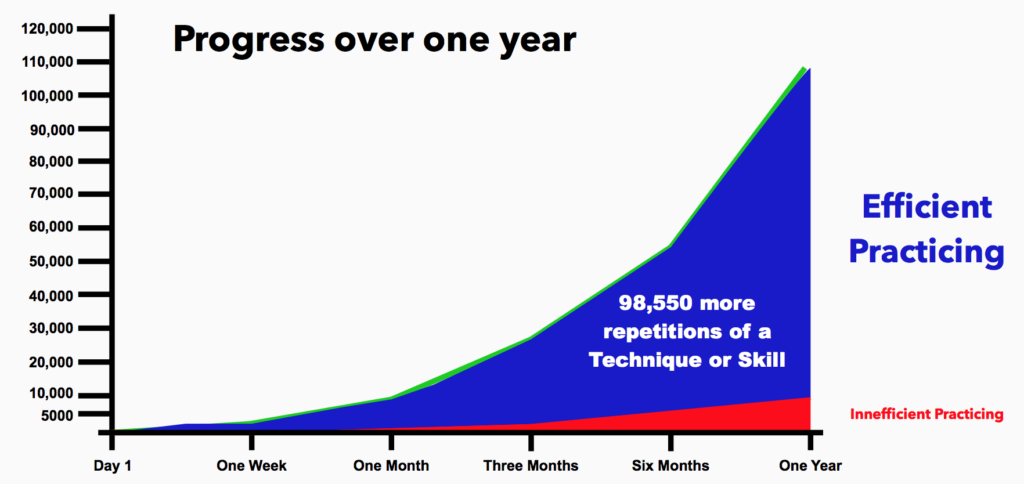
EFFICIENCY - PUTTING THE PRINCIPLE INTO PRACTICE
What we’ve done is used a simple example to demonstrate a wider principle.
The principle of zeroing in on the problem area to maximise results is very simple, yet powerful, and it is transferrable to many areas of guitar practice.
THE BIGGEST MISTAKE - "KNOWING" BUT NOT APPLYING
Often, guitar students believe they have absorbed this lesson and “got it” after hearing it once. You may even have heard this lesson before in some form. The only problem is, most students don’t actually apply it to what they are practicing.

For example, a common challenge for many students, and particularly in the beginning stages of guitar, is smooth chord changing.
When a tricky chord change is hampering your ability to play a song, what is the real issue holding you back?
It’s the chord change — this means, what happens at the actual moment of changing between the two chords. This is the thing to focus on in practice like a laser.
However, even when this is pointed out, many students simply continue to sit and repeat entire sections, slowing down and pausing to allow more time at challenging chord changes whenever they come up. The song never becomes fluid, and the chord change remains a bottleneck.
Just like Student A, the reason for their lack of progress is that for every ten or twenty minutes practice they think they’ve done, they’re only vaguely touching on the actual problem a few times.
By practicing inefficiently, it’s not unknown for people to spend months or even years on things that need only take a few weeks to learn.
However, the example could just as well be made for anything else, including more intermediate and advanced topics like learning guitar solos.
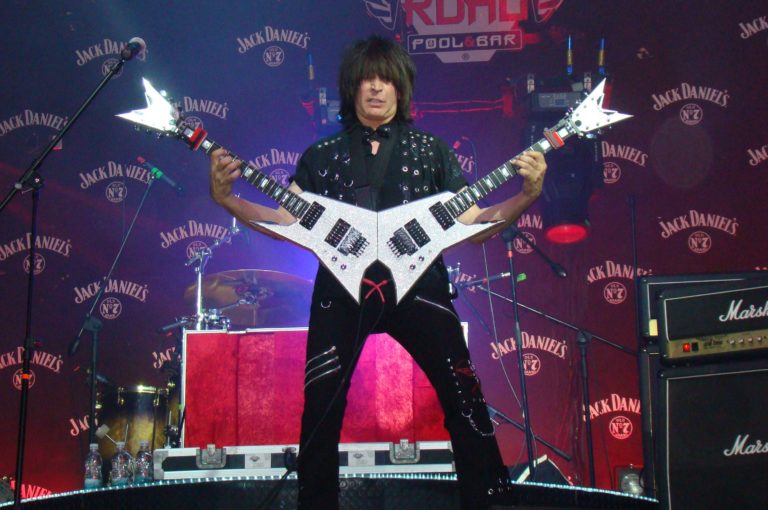
Instead of isolating the really challenging parts of a guitar solo to give the techniques the full proper attention they need, many students basically spend most of their time replaying things they can already do.
When it comes to the parts they still can’t do — which are the parts actually needing practiced — they’ll just slow down in the moment and pause to give themselves more time (…. or else just keep screwing the same bits up every time!).
They repeat like this, replaying the bits that make them feel good, ignoring the real problems, and nothing much improves. Just like Student A, they’re spending time, but they’re not really ‘practicing’ for most of that time.
So, my bet would be that even if you have already heard this advice in some form, you’re probably not applying it consistently, and you’re almost certainly not applying it to all the things you could and in all the ways that you could.
YOU NEED TO PRACTICE EFFICIENT PRACTICE
Efficient Practice is not something you simply hear about or read about one time and then have it mastered. Efficiency takes practice to develop and focus to maintain, otherwise even the best practiser can easily slip back into wasting huge amounts of time.
During your guitar practice sessions, ask yourself these three simple questions to ensure you are working efficiently, and to pull yourself back on track when you go off-course:
#1 - Am I really targeting my problem areas right now, or am I messing about with stuff I can already do?
#2 - Can I target this problem area even more directly and efficiently than I already am?
#3 - What is the real obstacle to my progress here, and what else could I do to zero in and really nail it?
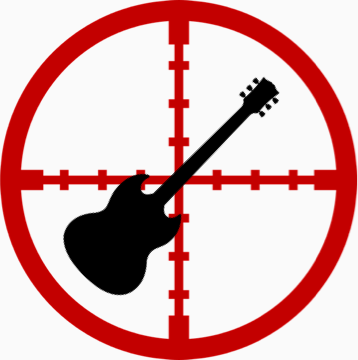
Get Motivated — Get Focused — Get Results!
It’s extremely motivating once you understand how to practice guitar properly, and can see how to start achieving the results you want.
Many guitar players look around at other players (these days particularly in videos online), and feel that other people are doing better than them.
When you don’t understand the reasons why people become really good at guitar, then comparisons like this are simply a source of frustration.
You could be comparing yourself to someone ‘better’ than you right now, who has a better baseline level right now. But if you change how you practice — as you can see — you could be overtaking them in a matter of weeks.
But rather than competing and comparing yourself with others, a much better idea is to look to ‘model’ the mindset, actions and habits of good players. All of these things are learnable and trainable.
You’ve learned a powerful practice habit today, and now you can use it to become better.
Efficient Practice is one of the secrets to how your favourite players got so good
If you think of a famous great guitar player — always, a naturally efficient practiser — who has been practicing like this for 10, 20, 30 or 40 years, can you imagine how many times they have played their favourite licks?
From our example, you can see how it would easily be an almost uncountable number of times.
It would be silly to compare the few hundred times you might’ve practiced a lick so far to the hundreds of thousands of times your favourite player has, then feel bad for coming up short.

Practice efficiently and consistently and you WILL get GREAT results.
The more efficiently you practice – the better you target what you actually need to improve – the faster the results you want will come.
Guitar practice should be fun and not feel like a chore, and you should always come away from a practice session knowing that you have moved your playing forward. If this is not the case, then there’s probably something going wrong somewhere, and your time is probably not being used as effectively as it could.

If you’re struggling to make good progress with your guitar practice, look for an experienced local guitar teacher who can help you reach the goals you want to achieve, and remove the obstacles in your way.